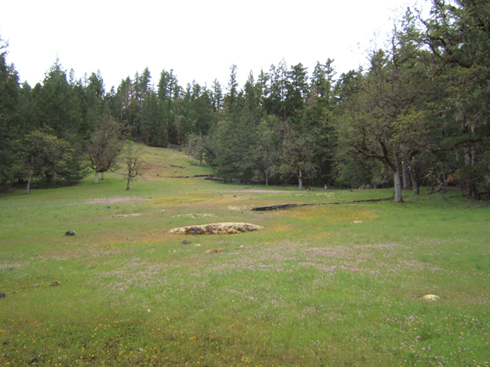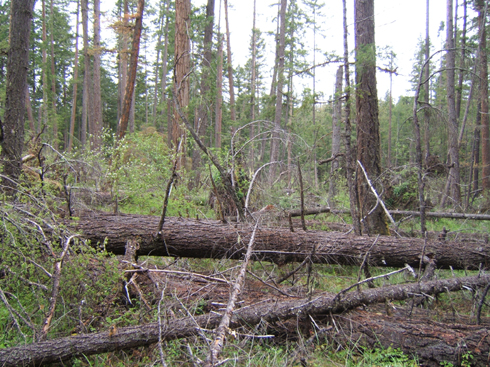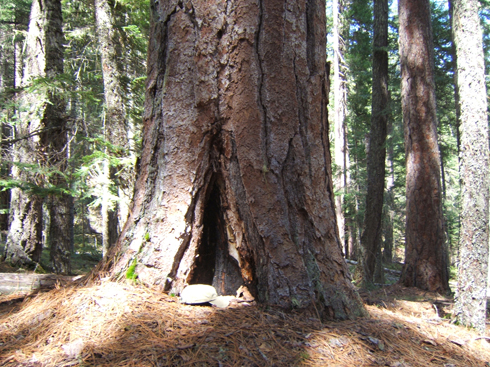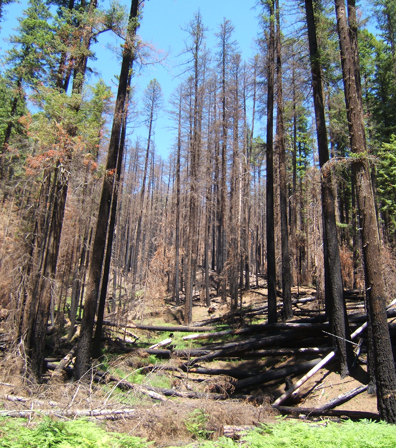Federal forest policy Forestry education Politics and politicians Restoring cultural landscapes Saving Forests The 2009 Fire Season
by admin
Douglas Co. Commissioner Joe Laurance July 15 Testimony
Today the House Subcommittee on National Parks, Forests and Public Lands held an Oversight Hearing on “Locally Grown: Creating Rural Jobs with America’s Public Lands”. Among the testimonies [here] was that of Joseph Laurance, County Commissioner, Douglas County, Oregon.
Commissioner Laurance brought up many important points, not the least of which is that that our national forests today are unnaturally loaded with fuels. Over 110 million acres are in Fire Regime Condition Class 2 and 3, the most hazardous conditions.
The safest condition is FRCC 1, of which there are 60 to million acres. Commissioner Laurance noted that FRCC 1 closely approximates the natural, historic conditions “characteristic of the ‘anthropogenic’ forest in the year 1800, immediately prior to the European American presence.”
The following is the full text of his remarks, with complementary photographs:
Testimony of Joseph Laurance, County Commissioner, Douglas County, Oregon before the House Natural Resources Committee, Subcommittee on National Parks, Forests and Public Lands, July 15, 2010.
Distinguished members of the committee,
At a meeting of Oregon county commissioners last summer, I complained to my colleagues that while endless debate continued in congress about how federal forests should be managed, fires were ravaging federal timberlands in my county and throughout the western United States. The worldwide financial crisis that was draining the national treasury made re-authorization of “Secure Rural Schools” funding seem doubtful, threatening many of Oregon’s 36 counties with social and economic ruin. Bad news just kept coming with the word that unemployment in Douglas County had reached 16.4% and if unreported joblessness was considered, was probably greater than the 19% experienced here during the height of the “Great Depression”.
Talks were ongoing in Copenhagen about greenhouse gas emissions while the three fires in my county burned toward an eventual total of 20,000 acres, equal to the greenhouse gasses emitted by one million cars in a year’s time. My fellow commissioners suggested that I craft a solution to the problems you of this body are all too familiar with. The resultant resolution* has been carefully considered by commissioners from across the western United States who helped in its preparation. It has been unanimously adopted by the Association of Oregon Counties, Western Interstate Region of Counties, and the National Association of Counties (NACo) Public Lands Committee and is expected to be adopted by NACo at its annual national conference next week.
Twenty years and twenty days ago the Northern Spotted Owl was listed as threatened under the federal “Endangered Species Act”. It was then thought that loss of old growth habitat through logging was the culprit causing a declining population. In response, federal timber harvests were vastly curtailed. The Umpqua National Forest in my county saw an annual harvest of 397 million board feet in 1988 reduced to 4 million board feet in 2002. In the years since a policy of “benevolent neglect” of federal lands has seen Spotted Owl numbers continue to decline through habitat destruction caused by increasingly numerous and intense forest fires and through predation by the Barred Owl which favors this new “unmanaged” forest habitat. Federal policy, which had been multiple use of the forest with an emphasis on industrial harvest, sought a new strategy which has yet to be formulated in all these intervening years.
The resolution presented you provides that needed new strategy, not only for Oregon but for all of our nation’s federal forests from Appalachia to Alaska. Federal forest managers would now have a clearly defined desired forest condition that must be obtained within a specified time. If this becomes the “Intent of Congress”, the Forest Service and BLM would join with private industry to restore forest health and rural economies without drawing on the national treasury.
The various Fire Regime Condition Classes described within the resolution indicate the extent of departure from the natural, historic conditions prior to fire exclusion or suppression. Typically, this departure occurred as native peoples were progressively displaced by European Americans during the westward expansion. Fire Regime Condition Class (FRCC) 1 is similar to the forest which European explorers first found here. That forest had been modified by fire for more than 6 thousand years to provide the native inhabitants with what were then life’s necessities. These included abundant wild game from the most productive and diverse wildlife habitat ever known on this continent. Similarly, the regular burning of competing vegetation permitted propagation of nut bearing trees and other food producing plants. Additionally, the historic “Healthy Forest” promoted pristine rivers, streams, and lakes that provided an abundant harvest of fish and waterfowl. Within FRCC 1 the risk of losing key ecosystem components to fire is low, while vegetation species composition, structure, and pattern are intact and functioning within the natural historic range.
FRCC 2 is a moderate departure from natural, historic conditions described above, with a moderate risk of losing key ecosystem components. Fire frequency, intensity, and size are increased with moderate increases in density, encroachment of shade tolerant tree species, or moderate loss of shade intolerant tree species.
FRCC 3 is the highest possible risk of catastrophic fire with dramatic changes to fire size, intensity, severity, and landscape patterns. High increases in density are typically associated with high mortality as a result of disease or insect infestation. These areas typically need high levels of restoration through hand or mechanical treatments. For purposes of this discussion, the full range of treatments available for active landscape scale management would be employed including fuels reduction, thinning of selected stands, and harvest where needed. These treatments must be successfully implemented before prescriptive fire can be used to maintain optimum forest conditions.
Of a total national forest system of 191 million acres, information provided by the Forest Service and derived from the ‘LANDFIRE Project” list an FRCC 3 total of 40,677,000 acres nationwide. FRCC 2 is said to be 72,553,000 acres; FRCC 1 is listed at 83,230,000 acres. Other information regarding Fire Classes is drawn from a 2007 report of the Inspector General of the USDA which lists FRCC 3 at 73,000,000 acres while other sources suggest FRCC 2 at 55,000,000 acres and FRCC 1 at 63,000,000 acres.
The total acreage of fuels reduction on the national forest by means of mechanical treatment to for 2008 (the last available figures) totaled 1.2 million acres.
Treatment required based on the figures above for the defined time period would amount to between 2 million and 3.65 million acres for reduction of FRCC 3 to FRCC 1 during the first 20 year period and between 2.75 and 3.63 million acres for a reduction from FRCC 2 to FRCC1 during the second 20 years.
More specific information regarding the work required and the costs associated will be forthcoming this August from a Title III study of 250,000 acres of Forest Service lands in my county which will identify, with scientific precision, the characteristics of that “anthropogenic” forest in the year 1800, immediately prior to the European American presence. These characteristics will closely approximate the natural, historic conditions described in FRCC 1 in a forest where all three classes now exist.
The study referred to is titled Upper Pre-Contact Reference Condition Study and is revealing a mosaic forest, heavily populated by people, who actively managed and maintained their travel ways, their camp sites, and their hunting and gathering grounds. These areas tended to be more open with fewer and larger trees together with a wide diversity of species. The forest we are finding on those sites today are more dense with the majority of the trees less than 150 years old and far fewer of the oaks and pines, although we find a profusion of relics of their existence.
A remnant or relic oak savanna in the South Umpqua watershed, Umpqua NF. Photo courtesy Mike Dubrasich. Click on photo for larger image.
The fuel buildup in the invasive conifer forest immediately adjacent to the above photo. Overtopped and now dead oak indicate that this area was once part of the oak savanna pictured above. The conifers are less than 150 years old. Photo courtesy Mike Dubrasich. Click on photo for larger image.
An ancient (400+ year) ponderosa pine “hearth” tree, culturally modified by pre-Contact residents. Note younger (<150 years) invasive conifers. South Umpqua watershed, Umpqua NF. Photo courtesy Mike Dubrasich. Click on photo for larger image.
Mortality of dense young (<150 years) conifers following the Boze Fire (2009, 10,645 acres [here]). South Umpqua watershed, Umpqua NF. Photo courtesy Mike Dubrasich. Click on photo for larger image.
The study area would seem to be an excellent candidate as a pilot project to provide specific information related to healthy forest restoration as envisioned by the resolution described earlier.
One example of a locally grown effort at forest restoration while creating rural jobs is Communities for Healthy Forests, Inc. CHF is a non profit organized in 2004 after devastating fires in Oregon galvanized Douglas County, Oregon community leaders into action. While attorneys, judges and elected officials deliberated upon what course of action to take on the millions of acres burned forest, the health of our rural communities and the health of the forests surrounding them were ignored. The decision to debate environmental policy in the face of an emergency becomes a decision to limit any restorative action. Economic opportunities of removing dead material to fund replanting and other restoration activities are lost as are the multitude of jobs these activities could support. The fire-killed material left on site becomes fuel for the next fire, and carbon to be emitted into the atmosphere, adding to the greenhouse gas emissions.
In contrast, actively restoring these insect and fire damaged forests can put local people to work. Putting people to work to restore overgrown forests can reduce the fire hazard; sustain healthy growing forest conditions resistant to catastrophic fire and insect attack. As scientists like Dr. Thomas Bonnicksen and many others tell us, these were the conditions our forests contained for thousands of years due to the influence of Native Americans, conditions and people which were sustained for thousands of years.
This active management is widely supported as shown by polls conducted by Communities for Healthy Forests as well as The Oregon Forest Resources Institute. The vast majority of Oregonians agree that we must act if we are to sustain our beautiful forests, our rural economy and the communities which are capable of sustaining them.
Similar projects have been undertaken by the Douglas Forest Protective Association who have provided job skills training for 2000 youth since 1971. Among their number is our current County Sheriff. Tasks being completed by area youth include fire training and fuels reduction projects. These youth will also be in the fire line in a few days time.
The Oregon Youth Conservation Corp has provided similar opportunities for an average of 400 youth per year for the past decade. Our local Phoenix School has done the same for 200 area youth this most recent school year with 250 expected to participate next year.
The resolution anticipates that significant volumes of biomass will be generated through forest restoration efforts. Three weeks ago I witnessed a demonstration of Biomass utilization in the midst of 10,000 acres of an insect infested pine forest. BioChar Products of Halfway, Oregon converted a bone dry ton of biomass into 120 gallons of Bio-oil while producing 400 lbs. of Bio-char, a rich growth medium. By means of this technology, my county could produce 120 million gallons of Bio-oil and 400 million pounds of Bio-char every year for at least 20 years and probably in perpetuity.
I wish to thank in particular Committee members Stephanie Herseth Sandlin and Peter DeFazio for their efforts to permit biomass and fuels reduction efforts on federal forest lands.
Forest Restoration is a complex and controversial topic that should be further discussed. I would be delighted to participate in other oversight hearings regarding that subject.
Much of the efforts described here have had their genesis in Title II and III projects funded through the Secure Rural Schools Act, which also provides vitally needed support for 4000 school districts and 700 counties nationwide.
Thank you for permitting me the honor of appearing before the House Sub-committee for National Parks, Forests and Public Lands.
Joseph Laurance
Douglas County Commissioner
Douglas County, Oregon
* A NACo Resolution to Promote Healthy Forest Ecosystems and Reduce the Release of Green House Gases through Active Management of the Nation’s Forests.
Issue:
Each year catastrophic wildfires throughout the nation contribute to global warming, jeopardize the national treasury, threaten fish and wildlife habitat, degrade both water and air quality, and cause devastation to forest dependent communities through loss of life, property, jobs, and the nation’s timber resource. Federal Forests should be actively managed to reduce the threat of wildfire and the release of greenhouse gases. Restoration and conservation of our National Forest will insure a sustainable economic and environmental legacy for future generations.
Proposed Policy:
NACo urges Congress to enact legislation to direct and enable federal forest management agencies to reduce Fire Regime Condition Class 3 (FRCC 3) to the standard of FRCC 1 in all federal forests by the year 2030, and to reduce FRCC 2 to the standard of FRCC 1 in all federal forests by the year 2050, through the means of active landscape scale management, fuels reduction, and immediate post-fire restoration.
Background:
Some 73 million acres or 38% of the nation’s federal forests are at “a high risk of ecologically destructive wild land fire” according to a 2007 report of the Inspector General of the USDA. An average of 7 million acres of forest has burned each year for the past 10 years in the US, primarily on federal lands. An estimated 47.5 Million Metric Tons of greenhouse gasses were released last year in the US through forest fire. An Executive Order of Oct.5, 2009 directs federal agencies to “consider and account for… emissions of greenhouse gases resulting from Federal land management practices”. With this resolution, NACo joins the White House in an effort to reduce greenhouse gasses caused by forest fires on federal lands.
Fiscal Urban/Rural Impact:
The cost to taxpayers to fight these fires exceeds $1 Billion each year. The value of the timber thus consumed costs taxpayers $10.5 Billion every year. If Congress enacts this legislation, then directs federal land management agencies to implement the resultant policy, thousands of communities throughout the nation would experience significant social and economic recovery with the creation and return of forest based employment as well as the many other benefits of multi-use forest management. Urban areas would benefit from reduced taxation which now serves to support neighboring distressed rural communities. The nation would benefit from reduced greenhouse gas emissions, increased carbon sequestration and storage, improved fish and wildlife habitat, enhanced air and water quality, greater quantities of biomass based energy and forest products derived from federal lands serving to increase the national treasury, and an ultimate reduction in the cost of federal land management, half of which is devoted to fire suppression each year.
Federal fiscal savings realized from this effort could contribute to offsets required for “Secure Rural Schools” funding, so vital to the educational and service needs of over 700 counties and 4000 school districts nationwide.
Sponsored by: Commissioner Joseph Laurance, Douglas County, Oregon
by Joe L.





Boy, this Laurance guy seems like he’s on the right track! Thanks, Mike.
Reply: IMHO, he’s the most skookum county commissioner in Oregon regarding forest issues. If we could replicate him and stick his clones on a dozen other county commissions, it would be a wonderful thing.